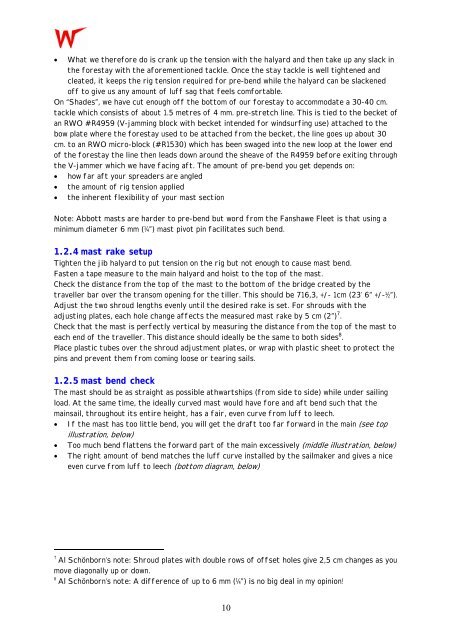File - Canadian Wayfarer Association
File - Canadian Wayfarer Association
File - Canadian Wayfarer Association
You also want an ePaper? Increase the reach of your titles
YUMPU automatically turns print PDFs into web optimized ePapers that Google loves.
• What we therefore do is crank up the tension with the halyard and then take up any slack in<br />
the forestay with the aforementioned tackle. Once the stay tackle is well tightened and<br />
cleated, it keeps the rig tension required for pre-bend while the halyard can be slackened<br />
off to give us any amount of luff sag that feels comfortable.<br />
On “Shades”, we have cut enough off the bottom of our forestay to accommodate a 30-40 cm.<br />
tackle which consists of about 1.5 metres of 4 mm. pre-stretch line. This is tied to the becket of<br />
an RWO #R4959 (V-jamming block with becket intended for windsurfing use) attached to the<br />
bow plate where the forestay used to be attached from the becket, the line goes up about 30<br />
cm. to an RWO micro-block (#R1530) which has been swaged into the new loop at the lower end<br />
of the forestay the line then leads down around the sheave of the R4959 before exiting through<br />
the V-jammer which we have facing aft. The amount of pre-bend you get depends on:<br />
• how far aft your spreaders are angled<br />
• the amount of rig tension applied<br />
• the inherent flexibility of your mast section<br />
Note: Abbott masts are harder to pre-bend but word from the Fanshawe Fleet is that using a<br />
minimum diameter 6 mm (¼”) mast pivot pin facilitates such bend.<br />
1.2.4 mast rake setup<br />
Tighten the jib halyard to put tension on the rig but not enough to cause mast bend.<br />
Fasten a tape measure to the main halyard and hoist to the top of the mast.<br />
Check the distance from the top of the mast to the bottom of the bridge created by the<br />
traveller bar over the transom opening for the tiller. This should be 716,3, +/- 1cm (23’ 6” +/-½”).<br />
Adjust the two shroud lengths evenly until the desired rake is set. For shrouds with the<br />
adjusting plates, each hole change affects the measured mast rake by 5 cm (2”) 7 .<br />
Check that the mast is perfectly vertical by measuring the distance from the top of the mast to<br />
each end of the traveller. This distance should ideally be the same to both sides 8 .<br />
Place plastic tubes over the shroud adjustment plates, or wrap with plastic sheet to protect the<br />
pins and prevent them from coming loose or tearing sails.<br />
1.2.5 mast bend check<br />
The mast should be as straight as possible athwartships (from side to side) while under sailing<br />
load. At the same time, the ideally curved mast would have fore and aft bend such that the<br />
mainsail, throughout its entire height, has a fair, even curve from luff to leech.<br />
• If the mast has too little bend, you will get the draft too far forward in the main (see top<br />
illustration, below)<br />
• Too much bend flattens the forward part of the main excessively (middle illustration, below)<br />
• The right amount of bend matches the luff curve installed by the sailmaker and gives a nice<br />
even curve from luff to leech (bottom diagram, below)<br />
7<br />
Al Schönborn’s note: Shroud plates with double rows of offset holes give 2,5 cm changes as you<br />
move diagonally up or down.<br />
8<br />
Al Schönborn’s note: A difference of up to 6 mm (¼”) is no big deal in my opinion!<br />
10


